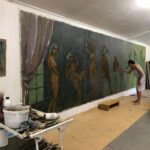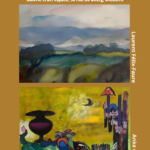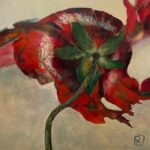Kwhezi Strydom
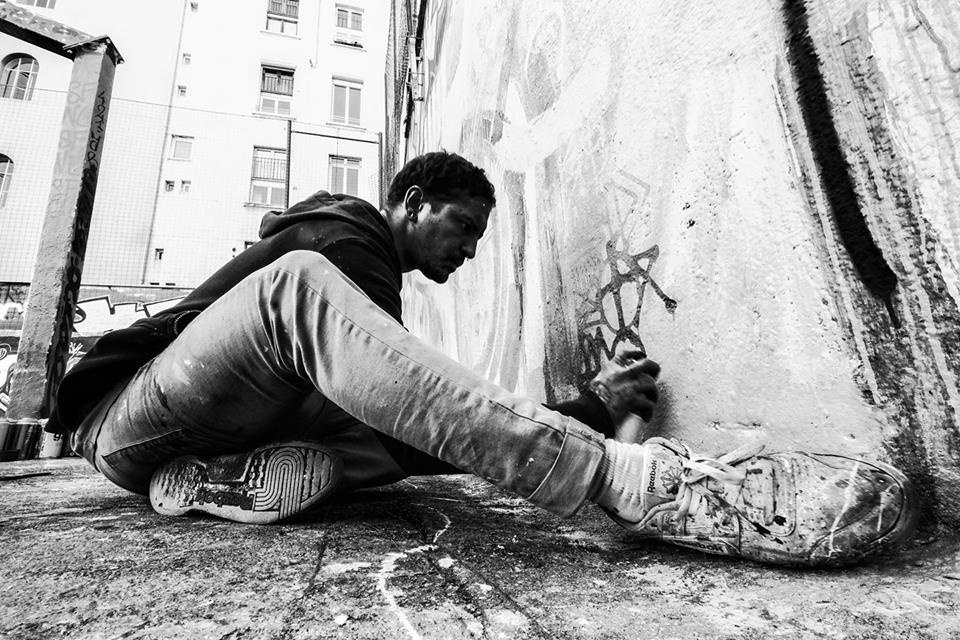
Kwhezi Strydom is still a young man, 42, but he doesn’t look it. Slender, with black hair and dark eyes, he embodies his parentage: his father is African from South Africa, his mother French, born in Tunisia. His mother is also a talented painter, and when Kwhezi was a child, she encouraged him to paint and draw and taught him the tricks of the trade. Kwhezi was born in the United States where his father worked. So, his environment was international and artistic from the start. However, he grew up in France and went to school in Lyon at the Marists, a religious order that, among other things, seeks to develop the creativity of its students. He was a gifted pupil with many interests, particularly in sciences, and after obtaining his BAC S, he went on to study astrophysics. During these years he also travelled to South Africa, his father’s homeland, the United States and South America.
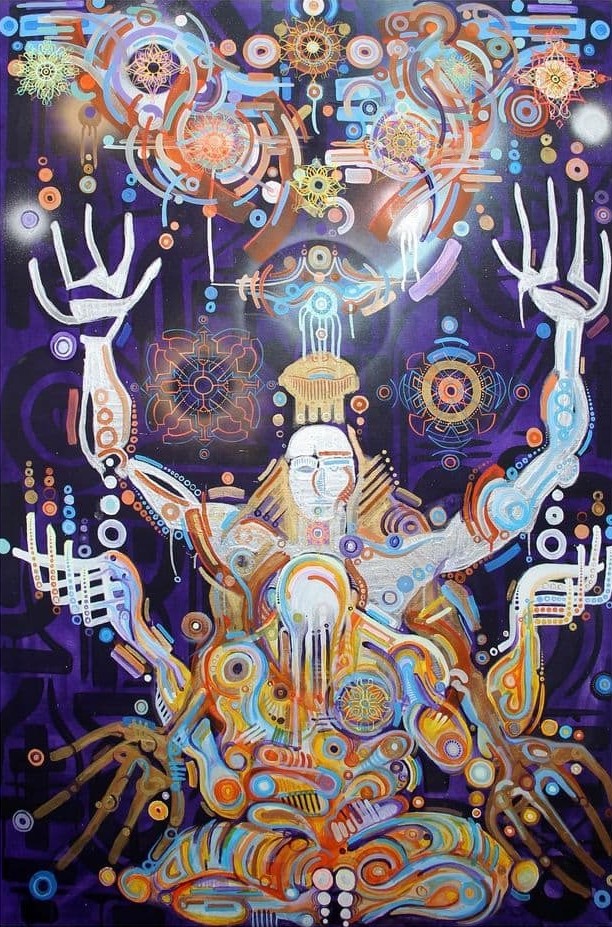
The 3 stages of life – Peru, 2017
Khwezi is grateful to be able to draw inspiration from different cultures, and if it is true that a painter’s work reveals who he is, then this feeling is fully justified. When I visited his exhibition at the “Usine” in le Poët Laval a few months ago, my immediate reaction was that his paintings came from “elsewhere”. To be more precise, they were original and contained stylistic elements from a variety of sources, and they were also free of the artistic conventions that one all too often encounters when visiting exhibitions of modern painters. His works are contemporary, skillfully painted and at the same time inspired by a wide range of ethical and cultural ideas and values. Some of these paintings were full of signs and symbols, and I felt like I was being transported back to ancient times, to Mesopotamian cuneiform writing or Egyptian hieroglyphics. Others, then again, are 100% contemporary and resemble paintings by artists such as Keith Haring, the American graffiti artist, who incorporates elements of popular culture into his work that immediately capture the eye and mind of the viewer. And then, to my surprise, there are paintings that could well be representations of the Hindu god Shiva, as well as portraits that are clearly inspired by African masks. I may be wrong, but a closer look at his paintings seemed to suggest a form of spirituality, as if the signs and components in Kwhezi’s paintings were reaching out to grasp the intangible, that which is beyond visible reality.
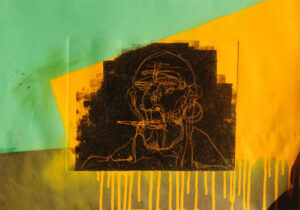
Engraving printed on an A2 format
As for the paintings recently exhibited in the “Usine” – some of them quite large – if I understood the young artist in charge of the gallery correctly, were mainly inspired by the transmutations of a butterfly. Finally, there are paintings that consist only of figures: in other words, they would normally be classified as conceptual art! The diversity that characterises Kwhezi’s work forces viewers to constantly readjust their perception, a shift in vision and understanding inherent in multiculturalism. Khwezi’s imagination, intellectual and artistic curiosity clearly show that diversity is in his genes and explains why he sees himself as an artist of the world. During our conversation, the first time I visited his studio, I was struck by a large unfinished painting on the wall. In some ways it reminded me of the work of Jean Michel Basquiat, an iconic painter of the New York scene in the seventies, one of whose paintings recently fetched $110 million! Interestingly, Khwezi, like Basquiat, is of mixed race, there is a certain similarity between them, both started out as graffiti artists and their mothers, who were painters, taught their sons the basics of the art.
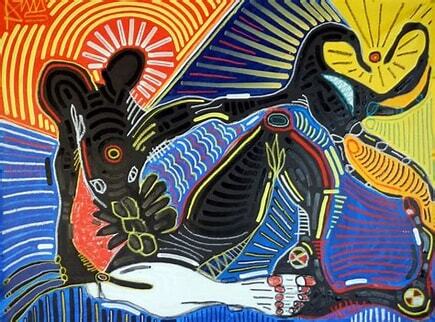
My dark light, 2015 – 100 x 160 cm
A major turning point in Khwezi’s life came after he became involved in street art, which is now recognised as a genuine form of artistic expression. Since childhood, he had always painted, but in the traditional way, using brushes, oils and acrylics on canvas. After becoming an accomplished graffiti artist, new horizons opened up for him. From then on, the scope of his work expanded spectacularly. His studio covered the whole city and there was no limit to the size of his work. He learnt to use the spray bomb, collage, graffiti, tagging and stencil techniques which he now applies to his studio paintings. With his friends and fellow graffiti artists, he would skateboard around the city of Lyon in search of walls and facades to cover with colourful frescoes. They were also driven by a slightly subversive spirit, which at times led them to defy the police by illegally protesting against social and political injustices on prohibited property.
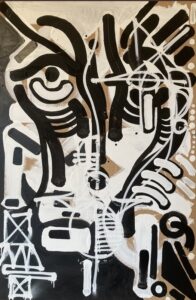
Q U, 2019 – 195 x 130 cm
Today, art collectors, leading galleries and museums have embraced this new form of visual art, and it is increasingly part of our urban landscape. Khwezi’s passion for street art confirmed his desire for independence and the need to express it in a powerful way. But there was still a period to bridge, working as a glassblower in Alsace before becoming a full-time painter. In addition to selling his paintings, with the growing popularity of street art, Kwhezi receives more and more requests from local authorities to decorate their cities and from private individuals who want to spruce up a wall of their home with art; so there is no shortage of work for Kwhezi! He also organises workshops and exhibitions and is currently studying art therapy to help people in need by developing their creativity. In short, a good and productive life as an artist!
http://www.khwezistrydom.fr/shop/paintings/
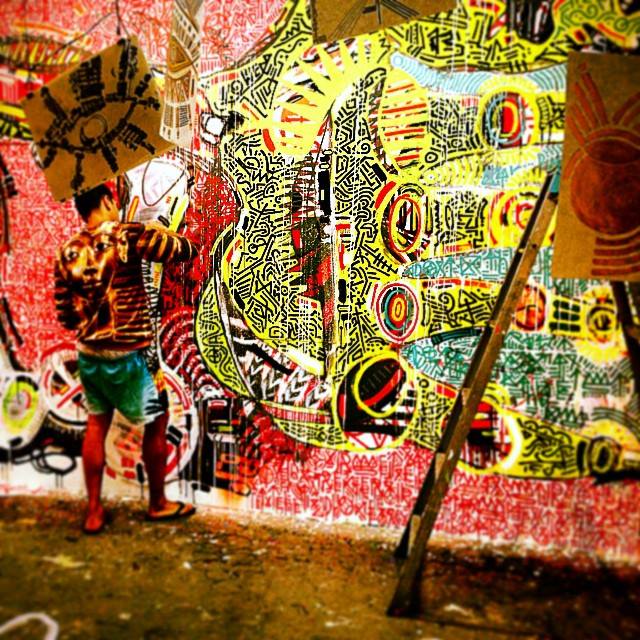
Posted in: Art
